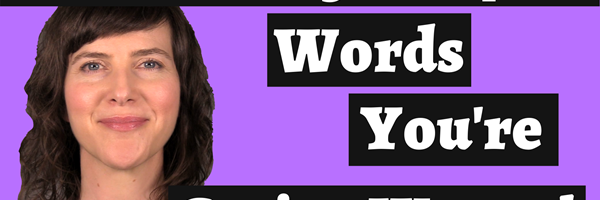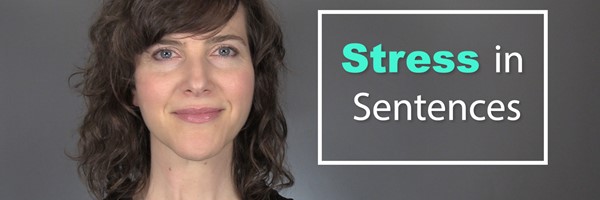(Video Transcript)
The rhythm of English: Stress-timed languages
Spoken English has a rhythm to it - a back-and-forth between stressed syllables and unstressed syllables. It sounds something like, DA - da - DA -dada - DA - da -DA. Long, short, Long, short, short, Long, short, long. This is because English is a stress-timed language, which means some syllables are longer and receive more stress, and some syllables are shorter, reduced, and receive less stress.
This is in contrast to other languages that are syllable-timed, like Mandarin Chinese and Spanish. In syllable-timed languages, all syllables are given approximately equal length and stress. These languages also lack reduced vowels.
When I talk about stress, I usually talk about a syllable being stressed or unstressed. Long syllable or short syllable. But stress can be more specific than just “stressed” and “unstressed”. There is a third type of stress that is found in some words that are 3 or more syllables.
Primary stress
Let’s talk about the first type of stress. A stressed syllable can have the primary stress in a word. That means it is stressed the most - it is said the longest, the loudest, and with the highest pitch in that word. Let’s look at the 3-syllable word understand /ˌʌn.dɚˈstænd/. Understand. Un-der-STAND. In this word, the third syllable, STAND, has the most stress, so it has the primary stress. Primary stress is noted in the IPA using this symbol: /ˈ/
Secondary stress
But listen to the first syllable of that word. Understand. Un-der-STAND. The first syllable, Un, has some stress, too. It is stressed more than the second syllable, der, but not stressed as much as the third syllable, STAND. Un-der-STAND. Da- da- DA. Un-der-STAND. This type of stress is called the Secondary stress. It’s still a stressed syllable, but it is stressed a little bit less because it doesn’t have the primary stress. It has secondary stress. Secondary stress is noted in the IPA using this symbol: /ˌ/
Weak stress
The second syllable of understand is der. Der. Der. This syllable is noticeably shorter and lower than the other two syllables. Understand. Understand. Der. Der. Der is the weak syllable of this word, and it is unstressed. There is no special IPA symbol for a weak or unstressed syllable, so you won’t see any symbols above or below the syllable.
3- and 4-syllable word examples
Let’s do some examples of 3- and 4-syllable words that have primary, secondary, and weak stress. And to help illustrate the stress patterns, I’m going to use the syllable DA in place of the words. DA is for a syllable with primary stress, Da is for a syllable with secondary stress, and da is for an unstressed syllable.
Let’s look at the 3-syllable word estimate, as in “I estimate this will cost a hundred bucks”. Estimate is a verb. It is spelled exactly like the noun estimate. But listen to the differences in the stress pattern and the vowel in the last syllable. Estimate (verb). Estimate (noun). Estimate (verb). Estimate (noun). Mate. Mit. The verb, estimate, has secondary stress on the last syllable. The stress pattern is: Primary stress, weak stress, secondary stress. DA - da - Da. Estimate. Estimate. The last syllable said just a bit longer than the weak middle syllable. EH-stuh-Mayt /ˈɛs təˌmeɪt/.
The noun, estimate, as in “I’ll give you an estimate in an hour”, has primary stress, then weak stress, weak stress, and the last syllable is short. Estimate. Estimate. DA- da-da.
Now let’s look at the 4-syllable word absolutely. Absolutely. Da-da-DA-da. Absolutely. /ˌæb.səˈlut.li/ The stress pattern in this word is secondary stress, weak stress, primary stress, weak stress. Ab-suh-LOOT-lee. Da-da-DA-da. Ab-suh-LOOT-lee.
I hope this video helped you to understand the difference between primary stress, secondary stress, and weak stress in American English. Thanks for watching! And I'd love to hear from you - contact me to learn how we can work together to perfect your American English pronunciation!
******************************************************************************************************
Interested in more American English pronunciation practice? Be sure to check out some of my most popular online resources (all free!):
- Dark L and Light L exercises: Free, downloadable and printable pdf
- Semi-Occluded Vocal Tract (SOVT) exercises: Free, downloadable and printable pdf
- Stressed and Unstressed Syllables exercises: Free, downloadable and printable pdf
- AH /ɑ/ and UH /ʌ/ Vowel pronunciation exercises: Free, downloadable and printable pdf
- American R /ɹ/ Consonant pronunciation exercises: Free, downloadable and printable pdf
- Vowel to Vowel Linking exercises: Free, downloadable and printable pdf
- Consonant to Vowel Linking exercises: Free, downloadable and printable pdf
- Word Reductions and English Rhythm exercises: Free, downloadable and printable pdf
- N /n/ and NG /ŋ/ Consonant pronunciation exercises: Free, downloadable and printable pdf
- Respiratory and Breath Support exercises: Free, downloadable and printable pdf
- International Phonetic Alphabet (IPA) for English Vowels: Free, downloadable and printable pdf
- International Phonetic Alphabet (IPA) for English Consonants: Free, downloadable and printable pdf
- Resonatory and Vocal Projection exercises: Free, downloadable and printable pdf
- Articulatory and Tongue Twister exercises: Free, downloadable and printable pdf
- Glottal Stop T /ʔ/, Flap T /ɾ/, and True T /t/ exercises: Free, downloadable and printable pdf
- EE /i/ and IH /ɪ/ Vowel pronunciation exercises: Free, downloadable and printable pdf
- Presentation Skills Training exercises: Free, downloadable and printable pdf
- Sentence-level Stress and Content Word Stress exercises: Free, downloadable and printable pdf



